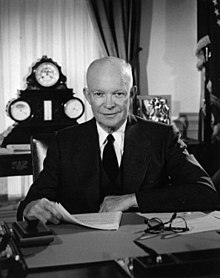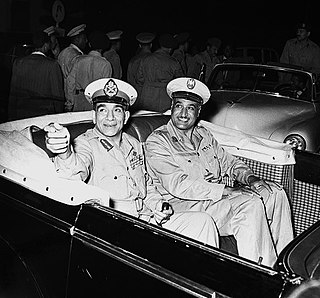Loading AI tools
Government administered by military forces From Wikipedia, the free encyclopedia
A stratocracy (from Ancient Greek στρατός (stratós) 'army' and κράτος (krátos) 'dominion, power'),[2] also called stratiocracy,[3][4][5] is a form of government headed by military chiefs.[6] The branches of government are administered by military forces, the government is legal under the laws of the jurisdiction at issue, and is usually carried out by military workers.[7]

The word stratocracy first appeared in 1652 from the political theorist Robert Filmer, being preceded in 1649 by stratokratia used by Claudius Salmasius in reference to the newly declared Commonwealth of England.[1][8] John Bouvier and Daniel Gleason describe a stratocracy as one where citizens with mandatory or voluntary military service, or veterans who have been honorably discharged, have the right to elect or govern. The military's administrative, judicial, and/or legislative powers are supported by law, the constitution, and the society.[6] It does not necessarily need to be autocratic or oligarchic by nature in order to preserve its right to rule. The political scientist Samuel Finer distinguished between stratocracy which was rule by the army and military regimes where the army did not rule but enforced the rule of the civil leaders.[9] Peter Lyon wrote that through history stratocracies have been relatively rare, and that in the latter half of the twentieth century there has been a noticeable increase in the number of stratocratic states due to the "rapid collapse of the West European thalassocracies".[8]

The Diarchy of Sparta was a stratocratic kingdom.[10] From a young age, male Spartans were put through the agoge, necessary for full-citizenship, which was a rigorous education and training program to prepare them to be warriors.[11] Aristotle describes the kingship at Sparta as "a kind of unlimited and perpetual generalship" (Pol. iii. 1285a), while Isocrates refers to the Spartans as "subject to an oligarchy at home, to a kingship on campaign" (iii. 24).[12]
One of the most notable and long-lived examples of a stratocratic state is Ancient Rome, though the stratocratic system developed over time.[13] Following the deposition of the last Roman king Lucius Tarquinius Superbus, Rome became an oligarchic Republic.[14][15] However, with the gradual expansion of the empire and conflicts with its rival Carthage, culminating in the Punic Wars, the Roman political and military system experienced drastic changes.[16] Following the so-called "Marian reforms", de facto political power became concentrated under military leadership, as the loyalty of the legionaries shifted from the Senate to its generals.[17]
Under the First Triumvirate[18] and during the subsequent civil wars, militarism influenced the formation of the Roman Empire, the head of which was acclaimed as "Imperator", previously an honorary title for distinguished military commanders.[19] The Roman army either approved of or acquiesced in the accession of every Roman emperor, with the Praetorian Guard having a decisive role in Imperial succession until Emperor Constantine abolished it.[20] Militarization of the Empire increased over time and emperors were increasingly beholden to their armies and fleets, yet how active emperors were in actually commanding in the field in military campaigns varied from emperor to emperor, even from dynasty to dynasty. The vital political importance of the army persisted up until the destruction of the Eastern (Byzantine) Empire with the fall of Constantinople in 1453.[21]
From 1170 to 1270, the kingdom of Goryeo was under effective military rule, with puppet kings on the throne serving mainly as figureheads.[22] The majority of this period was spent under the rule of the Choe family, who set up a parallel system of private administrative systems from their military forces.[23]

Cossacks were predominantly East Slavic people who became known as members of democratic, semi-military and semi-naval communities, predominantly located in Ukraine and in Southern Russia.[24] They inhabited sparsely populated areas and islands in the lower Dnieper,[25] Don, Terek, and Ural river basins, and played an important role in the historical and cultural development of both Russia and Ukraine.[26] The Zaporozhian Sich[27] was a Cossack semi-autonomous polity and proto-state[28] that existed between the 16th and 18th centuries, and existed as an independent stratocratic state as the Cossack Hetmanate for over a hundred years.[29][30][31]
The Military Frontier was a borderland of the Habsburg monarchy (which became the Austrian Empire and later the Austro-Hungarian Empire).[32][33] The military frontier acted as the cordon sanitaire against incursions from the Ottoman Empire. Located in the southern part of Hungarian crown land, the frontier was separated from local jurisdiction and was under direct Viennese central military administration from the 1500s to 1872. Unlike the rest of the Catholic dominated territory of the empire, the frontier area had relatively freer religious laws in order to attract settlements into the area.[34][35][36]

The closest modern equivalent to a stratocracy, the State Peace and Development Council of Myanmar (Burma), which ruled from 1997 to 2011,[37] arguably differed from most other military dictatorships in that it completely abolished the civilian constitution and legislature.[38][39] A new constitution that came into effect in 2010 cemented the Tatmadaw's hold on power through mechanisms such as reserving 25% of the seats in the legislature for military personnel.[40] The civilian constitutional government was dissolved again in the 2021 Myanmar coup d'état, with power being transferred back to the Tatmadaw through the State Administration Council.[41]
The United Kingdom overseas territory, the Sovereign Base Areas of Akrotiri and Dhekelia on the island of Cyprus, provides another example of a stratocracy: British Forces Cyprus governs the territory, with Air vice-marshal Peter J. M. Squires serving as administrator from 2022.[42] The territory is subject to unique laws different from both those of the United Kingdom and those of Cyprus.[43]

The political scientist Harold Lasswell wrote in 1941 of his concerns that the world was moving towards "a world of 'garrison states'" with the United States of America being one of the countries moving in that direction.[10] This was supported by the historian Richard Kohn in 1975 commenting on the US's creation of a military state during its early independence, and by the political scientist Samuel Fitch in 1985.[10] The historian Eric Hobsbawm has used the existence and power of the military-industrial complex in the US as evidence of it being a stratocratic state.[10] The expansion and prioritisation of the military during the administrations of Reagan and H. W. Bush have also been described as signs of stratocracy in the US.[44] The futurist Paul Saffo[45] and the researcher Robert Marzec[46] have argued that the post 9/11 projection of the United States was trending towards stratocracy.
The philosopher and economist Cornelius Castoriadis wrote in his 1980 text, Facing the War, that Russia had become the primary world military power. To sustain this, in the context of the visible economic inferiority of the Soviet Union in the civilian sector, he proposed that the society may no longer be dominated by the one-party state bureaucracy of the Communist Party but by a "stratocracy"[47][48][49] describing it as a separate and dominant military sector with expansionist designs on the world.[50][51] He further argued that this meant there was no internal class dynamic that could lead to social revolution within Russian society and that change could only occur through foreign intervention. Timothy Luke agreed that under the secretaryship of Mikhail Gorbachev this was the USSR moving towards a stratocratic state.[52]

Various countries in post-colonial Africa have been described as stratocracies.[53] The Republic of Egypt under the leadership of Nasser was described by the political theorist P. J. Vatikiotis as a stratocratic state.[54] The recent Egyptian governments since the Arab Spring,[55][56] including that of Abdel Fattah el-Sisi, have also been called stratocratic.[57] George commented in a 1988 paper that the military dictatorship of Idi Amin in Uganda and the apartheid regime in South Africa should be considered stratocracies.[58] Various previous Nigerian governments have been described as stratocratic in research, including the government under Olusegun Obasanjo, and the Armed Forces Ruling Council led by Ibrahim Babangida.[59] Under the 1978 constitution of eSwatini Sobhuza II appointed the Swazi army commander as the country's prime minister, and the second-in-command of the army as the head of the civil service board. This fusing of military and civil power continued in subsequent appointments, with many of the appointees viewing their civil roles as secondary to their military positions.[60] Ghana under Jerry Rawlings has also been described as being stratocratic in nature.[44] Karl Marx's term of barracks socialism was retermed by the political scientist Michel Martin in their description of socialist stratocracies in the Middle East, Latin America, and Africa, including specifically the People's Republic of Benin.[61][62] Martin also believes the praetorianism of francophone African republics can be called stratocratic, including the Côte d'Ivoire and the Central African Republic.[63]
The French historian François Raguenet wrote in 1691 of the stratocracy of Oliver Cromwell in the Protectorate, and commented that he believed William III of England was seeking to revive the stratocracy in England.[64]

The Prussian military writer Georg Henirich von Berenhorst wrote in hindsight that ever since the reign of the soldier king, Prussia always remained "not a country with an army, but an army with a country" (a quote often misattributed to Voltaire and Honoré Gabriel Riqueti, comte de Mirabeau).[65] It has been argued the subsequent dominance of the Kingdom of Prussia in the North German Confederation and German Empire and the expansive militarism in their administrations and policies, saw a continuance of the stratocratic Prussian government.[66]
British commentators such as Sir Richard Burton described the pre-Tanzimat Ottoman Empire as a stratocratic state.[67]
The Warlord Era of China is viewed as period of stratocratic struggles[68] with the researcher Peng Xiuliang pointing to the actions and policies of Wang Shizhen, a general and politician of the Republic of China, as an example of the stratocratic forces within the Chinese government of the time.[69]
Occupied Poland in World War I was put under the General-Militärgouvernementen (general military governments) of Germany and Austria-Hungary. This government was a stratocratic system where the military was responsible for the political administration of Poland.[70]
Various military juntas of central and south America have also been described as stratocracies.[71]
Since 1967, the Israeli occupation of the West Bank, East Jerusalem (both taken from Jordan), Sinai Peninsula, Gaza Strip (taken from Egypt) and the Golan Heights (taken from Syria) after the Six-Day War can be argued to have been under stratocratic rule.[72] While the West Bank and Gaza were governed by the Israeli Military Governorate and Civil Administration[73] which was later given to the Palestinian National Authority that governs the Palestinian territories, only East Jerusalem and the Golan Heights were annexed into Israeli territory from 1980 which is still internationally unrecognized and once referred to these territories by the United Nations as occupied Arab territories.[74][75]
Stratocratic forms of government have been popular in fictional stories.[76]

Seamless Wikipedia browsing. On steroids.
Every time you click a link to Wikipedia, Wiktionary or Wikiquote in your browser's search results, it will show the modern Wikiwand interface.
Wikiwand extension is a five stars, simple, with minimum permission required to keep your browsing private, safe and transparent.